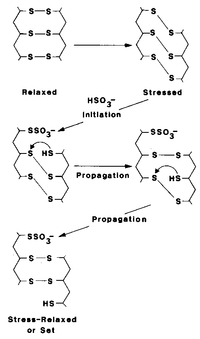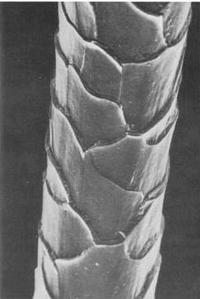


Chapter 5
I 1788 - State Of The Art In Textile Technology
II Australian Textiles - The Early Days
III Australian Textiles - The 20th Century
i Technology and Development
ii Australian Wool Textile Research
IV Australian Textiles - To Date
V Acknowledgements
References
Index
Search
Help
Contact us

Australian Wool Textile Research (continued)
In the CSIRO control unit, the comb sliver was continuously monitored by a sensing device of tongued and grooved rollers which sensed the thickness of the sliver emerging from the comb. This in effect monitored the production rate since the sliver travelled at a constant speed. The information derived in this way enabled the knives to be controlled so as to oppose any tendency to wander from the required production rate. The Unit was widely used on existing combs and also made available by the makers of the Noble comb as an accessory for new machines. It was the first time that transistors were applied to the textile industry.The well-known SI-RO-SET process (Fig. 17)[23] was released in 1957 when wool was under considerable pressure from synthetics, particularly polyesters that can be heat set to give permanent creases and pleats. Blends with these properties were being vigorously promoted by synthetic-fibre producers and making inroads into the pure-wool market. Something was urgently needed to produce similar effects in pure wool.

It was not possible to heat set wool in the same way as synthetics, a chemical treatment of the garment being required just before final pressing. Thus, the SI-RO-SET process involved changes in routine and installation of special equipment by the garment maker. Technical supervision and quality control testing were required to ensure that the treatment was done correctly. In Australia, 18 firms were licensed to use the process within six months of its release and there were many enquiries from overseas.
It is significant to note that 30 years later SI-RO-SET is still in fairly widespread use (despite the development since of other approaches to permanent press) with, for example, nearly 1 million units of all-wool trousers having been treated by the process in Japan in 1984/85.
As we have seen, the other easy-care property of wool which at that time was causing concern was its tendency to felt or shrink on washing. The use of domestic washing machines with spin drying had grown tremendously during the 1950s and 1960s, and the new synthetics could readily be washed and dried in these machines. And, of course, synthetic-fibre manufacturers were making much of this in their promotion.
The need for a reliable shrink-proofing process for wool had never been greater. The processes then available entailed either severe chemical treatment with, for example, chlorine or permanganate (with consequent problems of control of chemical damage), or the application of resins from organic solvents, with the consequent restrictions. A procedure was needed which minimised or eliminated damage and could be applied as an aqueous process.
It having been established that the application of polymers alone to untreated wool top gave little shrink-resistance, because the polymer did not spread over the surface of the fibre, a mild, wet pre-treatment with chlorine was invoked to increase the surface energy of the fibre.[24] A polymer -a polyamide -epichlorohydrin -was already commercially available as Hercosett 57 (Hercules Inc.) which had the right surface tension and other properties for spreading over the treated fibre surface. After application it was cured to form a film on the fibre. This swells on immersion in the wash liquor, causing compaction of the fibres within the yarn, so preventing fibre movement and hence shrinkage (Fig. 18).


(b) Scanning electron photomicrograph of a wool fivre after coating with Hercosett 57. The scales on the surface of the fibre are masked by the resin, which swells in water preventing preferential fibre movement and hence shrinkage.
Organisations in Australian Science at Work - CSIRO Division of Textile Industry
 |
Australian Academy of Technological Sciences and Engineering |  |
© 1988 Print Edition pages 281 - 282, Online Edition 2000
Published by Australian Science and Technology Heritage Centre, using the Web Academic Resource Publisher
http://www.austehc.unimelb.edu.au/tia/289.html